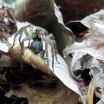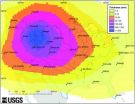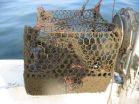(Press-News.org) TALLAHASSEE, Fla. — Was Mars — now a cold, dry place — once a warm, wet planet that sustained life? And if so, how long has it been cold and dry?
Research underway at the National High Magnetic Field Laboratory may one day answer those questions — and perhaps even help pave the way for future colonization of the Red Planet. By analyzing the chemical clues locked inside an ancient Martian meteorite known as Black Beauty, Florida State University Professor Munir Humayun and an international research team are revealing the story of Mars' ancient, and sometimes startling, climate history.
The team's most recent finding of a dramatic climate change appeared in Nature Geoscience, in the paper "Record of the ancient Martian hydrosphere and atmosphere preserved in zircon from a Martian meteorite."
The scientists found evidence for the climate shift in minerals called zircons embedded inside the dark, glossy meteorite. Zircons, which are also abundant in the Earth's crust, form when lava cools. Among their intriguing properties, Humayun says, is that "they stick around forever."
"When you find a zircon, it's like finding a watch," Humayun said. "A zircon begins keeping track of time from the moment it's born."
Last year, Humayun's team correctly determined that the zircons in its Black Beauty sample were an astonishing 4.4 billion years old. That means, Humayun says, it formed during the Red Planet's infancy and during a time when the planet might have been able to sustain life.
"First we learned that, about 4.5 billion years ago, water was more abundant on Mars, and now we've learned that something dramatically changed that," said Humayun, a professor of geochemistry. "Now we can conclude that the conditions that we see today on Mars, this dry Martian desert, must have persisted for at least the past 1.7 billion years. We know now that Mars has been dry for a very long time."
The secret to Mars' climate lies in the fact that zircons (ZrSiO4) contain oxygen, an element with three isotopes. Isotopes are atoms of the same element that have the same number of protons but a different number of neutrons — sort of like members of a family who share the same last name but have different first names.
On Mars, oxygen is distributed in the atmosphere (as carbon dioxide, molecular oxygen and ozone), in the hydrosphere (as water) and in rocks. In the thin, dry Martian atmosphere, the sun's ultraviolet light causes unique shifts in the proportions in which the three isotopes of oxygen occur in the different atmospheric gases.
So when water vapor that has cycled through the Martian atmosphere condenses into the Martian soil, it can interact with and exchange oxygen isotopes with zircons in the soil, effectively writing a climate record into the rocks. A warm, wet Mars requires a dense atmosphere that filters out the ultraviolet light making the unique isotope shifts disappear.
In order to measure the proportions of the oxygen isotopes in the zircons, the team, led by scientist Alexander Nemchin, used a device called an ion microprobe. The instrument is in the NordSIMS facility at the Swedish Museum of Natural History, directed by team member Martin Whitehouse.
Because of these precise measurements, said Humayun, "we now have an isotopic record of how the atmosphere changed, with dates on it."
The Black Beauty meteorite Humayun's team is studying was discovered in the Sahara Desert in 2011. It's also known as NWA 7533, which stands for Northwest Africa, the location where it was found.
In all, more than five pieces of Black Beauty were found by Bedouin tribesmen, who make a living scouring the Sahara for meteorites and fossils that they can sell. The zircons analyzed by Humayun's team were from Black Beauty samples kept in Paris.
INFORMATION:
CONTACT: Munir Humayun, Florida State University
(850) 544-5740; Humayun@magnet.fsu.edu
Alexander Nemchin, Swedish Museum of Natural History
+46 (0) 721907772; a.nemchin@curtin.edu.au
Scientist uncovers red planet's climate history in unique meteorite
2014-08-27
ELSE PRESS RELEASES FROM THIS DATE:
MU researchers develop more accurate Twitter analysis tools
2014-08-27
COLUMBIA, Mo. – "Trending" topics on the social media platform Twitter show the quantity of tweets associated with a specific event. However, trends only show the highest volume keywords and hashtags, and may not give qualitative information about the tweets themselves. Now, using data associated with the Super Bowl and World Series, researchers at the University of Missouri have developed and validated a software program that analyzes event-based tweets and measures the context of tweets rather than just the quantity. The program will help Twitter analysts gain better ...
Marijuana compound may offer treatment for Alzheimer's disease
2014-08-27
Tampa, FL (Aug. 26, 2014) -- Extremely low levels of the compound in marijuana known as delta-9-tetrahydrocannabinol, or THC, may slow or halt the progression of Alzheimer's disease, a recent study from neuroscientists at the University of South Florida shows.
Findings from the experiments, using a cellular model of Alzheimer's disease, were reported online in the Journal of Alzheimer's Disease.
Researchers from the USF Health Byrd Alzheimer's Institute showed that extremely low doses of THC reduce the production of amyloid beta, found in a soluble form in most aging ...
More wolf spiders feasting on American toads due to invasive grass, UGA study shows
2014-08-27
Athens, Ga. – An invasive grass species frequently found in forests has created a thriving habitat for wolf spiders, who then feed on American toads, a new University of Georgia study has found.
Japanese stiltgrass, which was accidentally introduced to the U.S. in the early 1900s, is one of the most pervasive invasive species and has spread to more than a dozen states in the past century, particularly in the Southeast. Typically found along roads and in forests, it can survive in widely diverse ecosystems and has been found to impact native plant species, invertebrate ...
Orion rocks! Pebble-size particles may jump-start planet formation
2014-08-27
Rocky planets like Earth start out as microscopic bits of dust tinier than a grain of sand, or so theories predict.
Astronomers using the National Science Foundation's (NSF) Green Bank Telescope (GBT) have discovered that filaments of star-forming gas near the Orion Nebula may be brimming with pebble-size particles -- planetary building blocks 100 to 1,000 times larger than the dust grains typically found around protostars. If confirmed, these dense ribbons of rocky material may well represent a new, mid-size class of interstellar particles that could help jump-start ...
AGU: Yellowstone supereruption would send ash across North America
2014-08-27
WASHINGTON, D.C. – In the unlikely event of a volcanic supereruption at Yellowstone National Park, the northern Rocky Mountains would be blanketed in meters of ash, and millimeters would be deposited as far away as New York City, Los Angeles and Miami, according to a new study.
An improved computer model developed by the study's authors finds that the hypothetical, large eruption would create a distinctive kind of ash cloud known as an umbrella, which expands evenly in all directions, sending ash across North America.
A supereruption is the largest class of volcanic ...
'Junk' blood tests may offer life-saving information
2014-08-27
Tel Aviv — Some 30 percent of all positive hospital blood culture samples are discarded every day because they're "contaminated" — they reflect the presence of skin germs instead of specific disease-causing bacteria.
Rather than toss these compromised samples into the trash, clinicians may be able to use the resistance profiles of skin bacteria identified by these tests to treat patients with antibiotics appropriate to their ailment, Tel Aviv University researchers say. Dr. Gidi Stein and Dr. Danny Alon of TAU's Sackler Faculty of Medicine and the Department of Internal ...
Big data approach identifies Europe's most dangerous human and domestic animal pathogens
2014-08-27
The pathogens posing the greatest risk to Europe based upon a proxy for impact have been identified by University of Liverpool researchers using a 'big data' approach to scientific research.
The researchers from the University's Institute of Infection and Global Health ranked the top 100 pathogens affecting humans and the top 100 affecting domestic animals using a system which, they believe, will help governments across the continent plan for risks associated with the spread of infectious diseases, including as a result of climate change, and for biosecurity.
The top ...
Drug represents first potential treatment for common anemia
2014-08-27
(WASHINGTON, August, 27, 2014) – An experimental drug designed to help regulate the blood's iron supply shows promise as a viable first treatment for anemia of inflammation, according to results from the first human study of the treatment published online today in Blood, the Journal of the American Society of Hematology
Anemia is a condition that occurs when red blood cells are in short supply or do not function properly. When an individual has anemia, the body does not get enough oxygen, since there are fewer red blood cells to carry the iron-rich protein hemoglobin ...
Pacific plate shrinking as it cools
2014-08-27
HOUSTON – (Aug. 27, 2014) – The tectonic plate that dominates the Pacific "Ring of Fire" is not as rigid as many scientists assume, according to researchers at Rice University and the University of Nevada.
Rice geophysicist Richard Gordon and his colleague, Corné Kreemer, an associate professor at the University of Nevada, Reno, have determined that cooling of the lithosphere -- the outermost layer of Earth -- makes some sections of the Pacific plate contract horizontally at faster rates than others and cause the plate to deform.
Gordon said the effect detailed this ...
NOAA's Marine Debris Program reports on the national issue of derelict fishing traps
2014-08-27
Thousands of fishing traps are lost or abandoned each year in U.S. waters and become what are known as derelict traps, which continue to catch fish, crabs, and other species such as turtles. These traps result in losses to habitat, fisheries, and the watermen who depend on the resources--losses that are largely preventable, according to a newly published NOAA study.
The report, published in the Marine Pollution Bulletin, is the first of its kind to examine the derelict fish trap problem, and so-called "ghost fishing," nationally, and recommends actions to better manage ...





